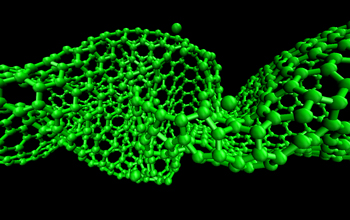Multimedia Gallery
Buckling and Twisting Nanotubes
High-intensity, atomic-level sonic boomlets cause nanotubes to buckle and twist at "compression-concentration zones."
Researchers at Brown University and in Korea have described the dynamics behind
cutting single-walled carbon nanotubes, cylindrical structures just 1/50,000th the width
of a human hair. The tubes are compressed by potent sonic booms, causing them to
buckle at certain points at helical, 90-degree angles. The finding could lead to better quality
nanotubes for potential use in automotive, electronics, optics and other fields. The results of this research appeared in the Proceedings of the Royal Society A. The research was supported in part by a grant from the National Science Foundation.
To learn more about this research, see the Brown University press release "How do you cut a nanotube? Lots of compression." (Date of Image: unknown)
Credit: Kim Lab, Brown University
Images and other media in the National Science Foundation Multimedia Gallery are available for use in print and electronic material by NSF employees, members of the media, university staff, teachers and the general public. All media in the gallery are intended for personal, educational and nonprofit/non-commercial use only.
Images credited to the National Science Foundation, a federal agency, are in the public domain. The images were created by employees of the United States Government as part of their official duties or prepared by contractors as "works for hire" for NSF. You may freely use NSF-credited images and, at your discretion, credit NSF with a "Courtesy: National Science Foundation" notation.
Additional information about general usage can be found in Conditions.
Also Available:
Download the high-resolution JPG version of the image. (813 KB)
Use your mouse to right-click (Mac users may need to Ctrl-click) the link above and choose the option that will save the file or target to your computer.



